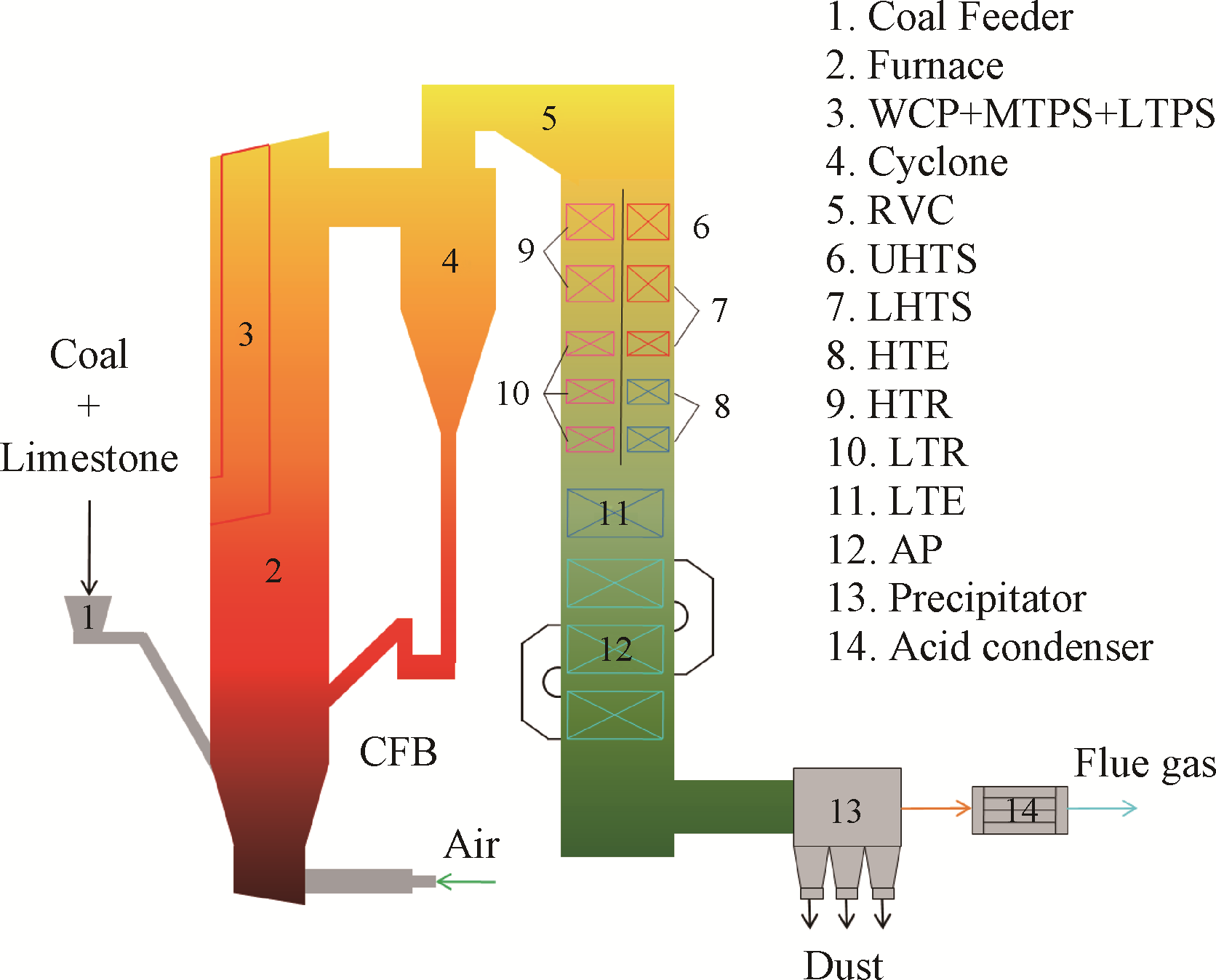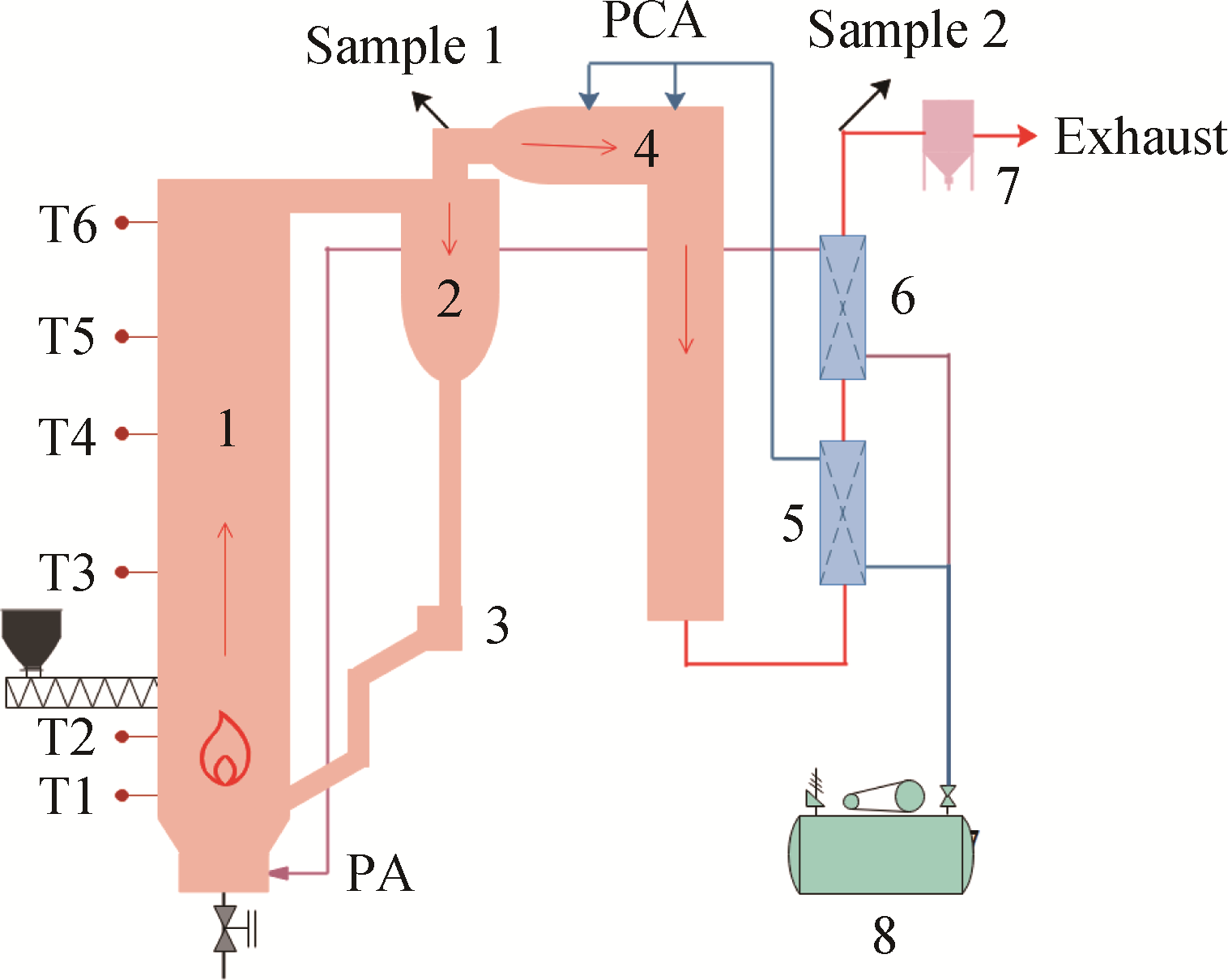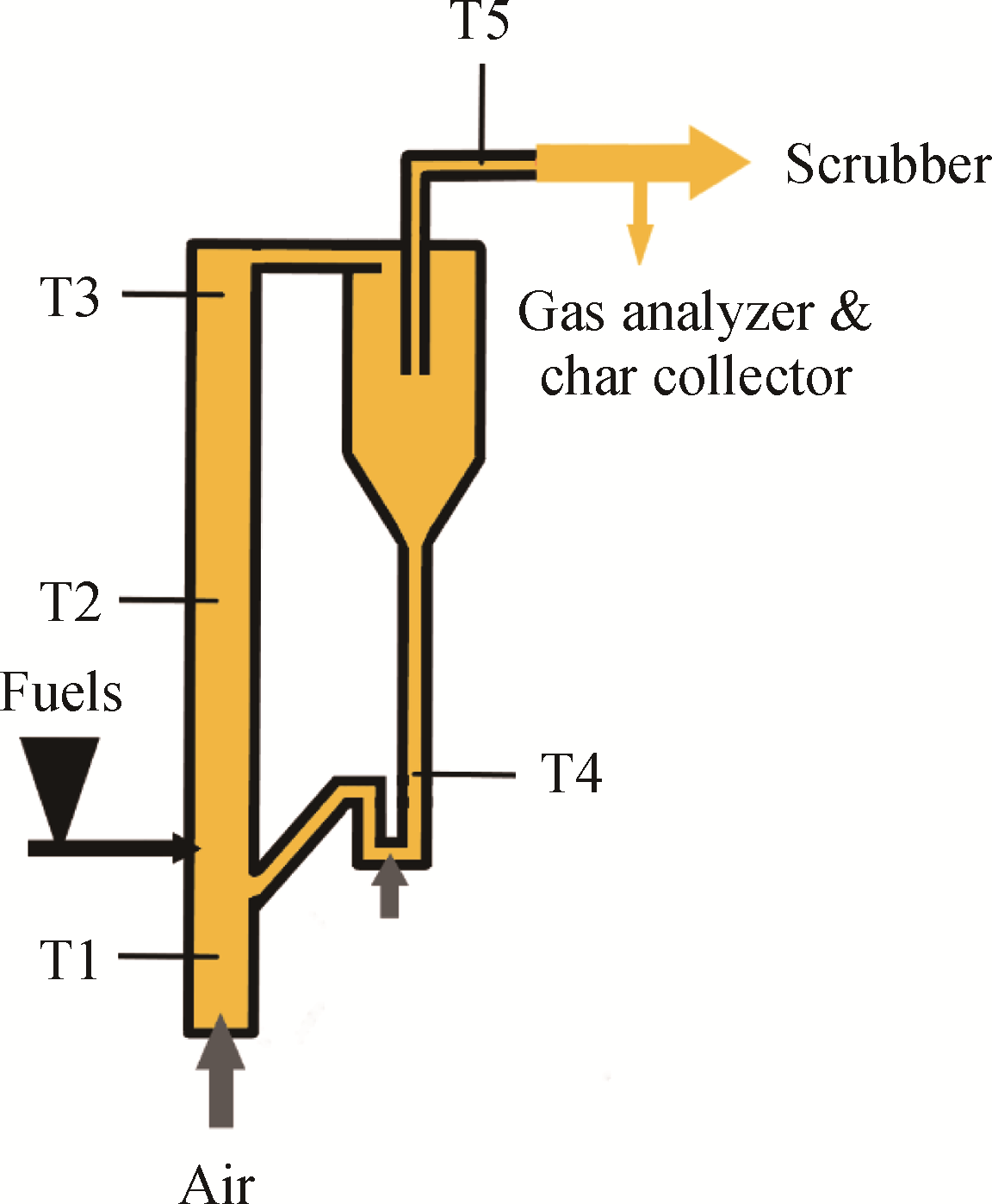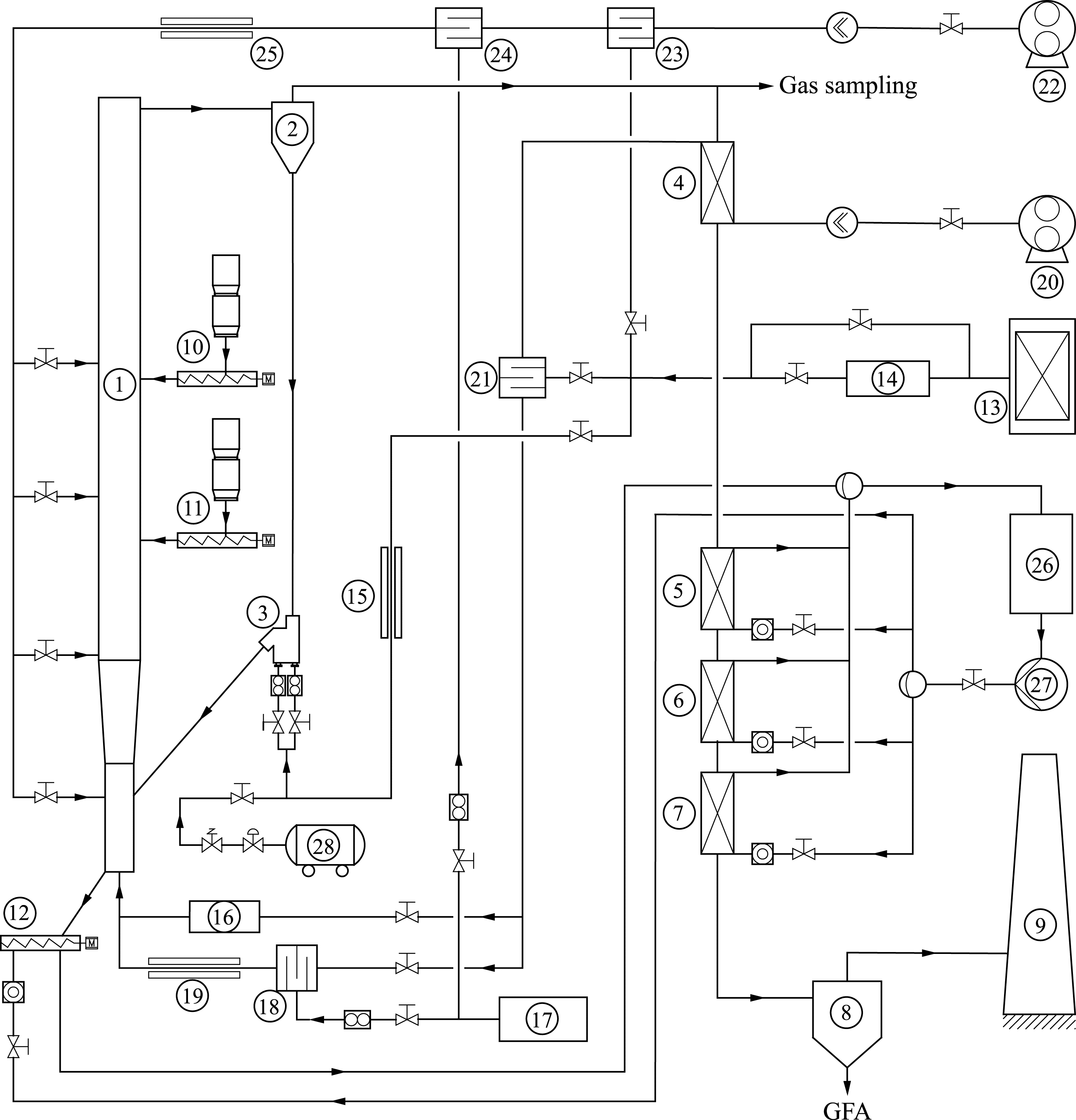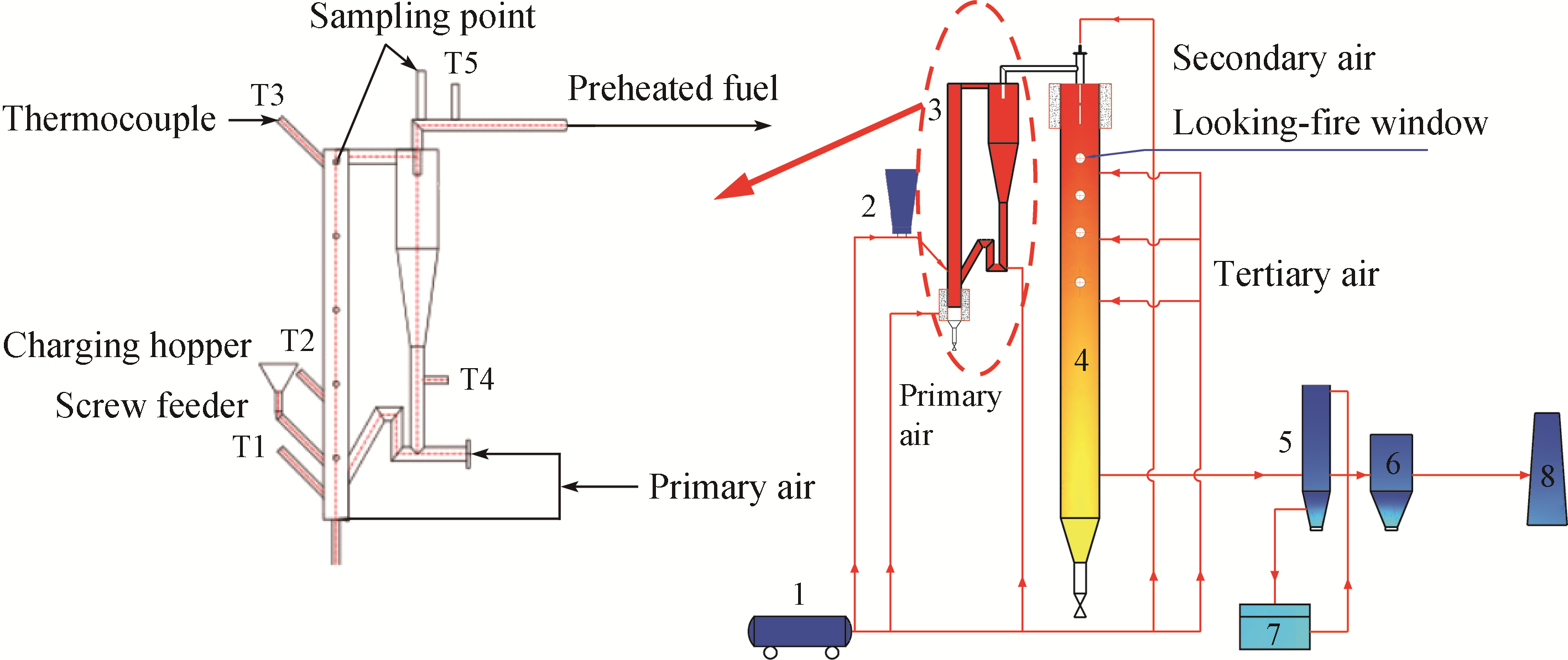08 September 2023, Volume 32 Issue 5
-
Select all|
-
Journal of Thermal Science. 2023, 32(5): 1721-1721. https://doi.org/10.1007/s11630-023-1892-x
Under the carbon peaking and carbon neutrality strategy, the demand for diversified, clean and low-carbon energy utilization is increasingly urgent. The low-carbon development and energy security are facing major challenges. It is therefore necessary to build new ways of low-carbon use for high-carbon energy and promote the innovation of low-carbon heat conversion technology.
Clean and efficient utilization of coal plays a decisive role in the energy revolution and has faced big challenges. Circulating fluidized bed (CFB) combustion technology, as an advanced energy utilization technology, has been developed rapidly in the last 30 years. It has the advantages of wide fuel adaptability, good environmental performance and wide range of load regulation. CFB technology will play an important role in the clean and efficient utilization of coal for carbon neutrality.
This special issue covers six subjects and focuses on the experiments, simulations and applications of Circulating fluidized bed technologies and relevant fields. Through rigorous peer review, nineteen original research papers have been accepted, which are broadly categorized into Power generation technology, Boiler deep peak regulation technology, Solid waste firing and co-firing technology, Industrial low-carbon technology, Ultra-low pollutant emission technology, Oxy-fuel combustion technology and Energy storage technology.
We would like to express our gratitude to all the contributors, reviewers and the journal office team for their great support in ensuring the high quality of this special issue. -
Journal of Thermal Science. 2023, 32(5): 1722-1736. https://doi.org/10.1007/s11630-023-1864-1Integrating a high proportion of intermittent renewable energy provides a solution for the higher peak-shaving capacity of coal-fired power plants. Oxy-fuel combustion is one of the most promising carbon reduction technologies for coal-fired power plants. This study has proposed a novel oxy-fuel power plant that is coupled with both liquid O2 storage and cold energy recovery systems in order to adapt to the peak-shaving requirements. The liquid O2 storage system uses cheap valley electricity to produce liquid O2 for a later use in the peak period to enhance the peak-shaving capacity. Meanwhile, the cold energy recovery system has been introduced to recover the physical latent energy during the phase change of liquid O2 to increase the power generation in the peak period. Technical economies of three power plants, i.e. a 330 MW (e) oxy-fuel power plant as reference (Case 1), the same power plant coupled with only liquid O2 storage system (Case 2), and the same power plant coupled with both liquid O2 storage and cold energy recovery systems (Case 3), have been analyzed and compared. Thermodynamic performance analysis indicates that the peaking capacity of Case 3 can reach the range of 106.03 to 294.22 MW (e), and the maximum peak-shaving coefficient can be as high as 2.77. Exergy analysis demonstrates that the gross exergy efficiency of Cases 2 and 3 reaches 32.18% and 33.57%, respectively, in the peak period, which are significantly higher than that of 26.70% in Case 1. Economic analysis shows that through selling the liquid O2 and liquid CO2, combined with carbon trading, the levelized cost of electricity (LCOE) of the three cases have been greatly reduced, with the lowest one of 30.90 USD/MWh shown in Case 3. For a comprehensive consideration, Case 3 can be considered a future reference of oxy-fuel power plant with the best thermodynamic and economic performance.
-
Journal of Thermal Science. 2023, 32(5): 1737-1749. https://doi.org/10.1007/s11630-023-1784-0The low net efficiency of oxy-fuel circulating fluidized bed (CFB) combustion is mainly due to the addition of air separation unit (ASU) and carbon dioxide compression and purification unit (CPU). High oxygen concentration is one of the effective methods to improve the net efficiency of oxy-fuel combustion technology in CFB. In this research, a series of calculation and simulation were carried out based on Aspen Plus platform to provide valuable information for further investigation on the CFB oxy-fuel combustion system with high oxygen concentration (40%, 50%). A CFB oxy-fuel combustion system model with high oxygen concentration was established including ASU, CPU and CFB oxy-fuel combustion and heat exchange unit. Based on the simulation data, energy and exergy efficiency were analyzed to obtain the following results. The cross-sectional area of furnace and tail flue of 50% CFB oxy-fuel combustion boiler are 43% and 56% of the original size respectively, reducing the construction and investment cost effectively. With the increase of oxygen concentration, the net efficiency of power generation increased significantly, reaching 24.85% and increasing by 6.09% under the condition of 50% oxy-fuel combustion. The total exergy loss increases with the increase of oxygen concentration. In addition, the exergy loss of radiation heat transfer is far higher than convection heat transfer.
-
Journal of Thermal Science. 2023, 32(5): 1750-1757. https://doi.org/10.1007/s11630-023-1850-7Pressurised oxy-fuel combustion (POFC) is a clean and efficient combustion technology with great potential. Due to the recycling of flue gas, the concentration of steam in the flue gas is higher than that of conventional combustion, which enriches the free radical pool in the flue gas and thus affects the emission of gaseous pollutants. Therefore, further research into the effect of high steam concentrations on NOx emission mechanisms in POFC is necessary. In this work, a fixed-bed reactor was used to conduct combustion experiments of volatiles and combined with chemical kinetic models to study the NO release characteristics for different pressures and steam concentrations in an O2/CO2 atmosphere at 800°C/900°C temperature. The results of the study indicated that the volatile nitrogen comes from the pyrolysis of part of pyrrole, pyridine, and all quaternary nitrogen in coal. The increase in temperature promoted the formation of NO during combustion. Higher pressure affects the main reaction pathway for NO formation, promoting NO consumption by HCCO and C2O groups while enhancing the overall NO reduction. Steam promoted NO consumption by NCO. In addition, steam increased the amount of H/OH groups during the reaction, which affected both NO formation and consumption. However, from the overall effect, the steam still inhibits the emission of NO.
-
Journal of Thermal Science. 2023, 32(5): 1758-1770. https://doi.org/10.1007/s11630-023-1866-zThe large-scale integration of new energy generation has put forward higher requirements for the peak-shaving capability of thermal power. The circulating fluidized bed (CFB) depends on the advantages of a wide load adjustment range and low cost of pollutant control to become a good peak shaving power supply. However, the large delay and inertia caused by its unique combustion mode make it very difficult to change the load quickly. To further understand the factors that affect the load change of CFB, and explore the method of increasing CFB load change rate, the load change experiment on the combustion side was carried out in the 0.1 MW CFB experiment platform. The influence law of bed material amount and fuel particle size on load change of CFB combustion side was revealed for the first time. The results indicated that the increase of bed material amount was beneficial to improve the load change rate on the combustion side of CFB and reduce the carbon content of fly ash, but had no obvious effect on NOx emission. When the bed height at rest increased from 200 mm to 400 mm, the load change rate of the CFB combustion side load from 50% to 75% increased from 0.78%/min to 1.14%/min, and the carbon content of fly ash at 75% load decreased from 26.6% to 24.9%. In addition, the reduction of fuel particle size positively improved the load change rate on the combustion side of the CFB and reduced NOx emission but had a negative effect on reducing the carbon content of fly ash. When the fuel particle size decreased from 0–1 mm to 0–0.12 mm, the load change rate of CFB combustion side load from 50% to 75% increased from 0.78%/min to 1.09%/min, and the NOx emission and carbon content of fly ash at 75% load decreased from 349.5 mg/m3 to 194.1 mg/m3 and increased from 26.6% to 31.8%, respectively.
-
Journal of Thermal Science. 2023, 32(5): 1771-1783. https://doi.org/10.1007/s11630-023-1888-6The operating principles of Circulating Fluidized Bed (CFB) boilers involve a significant amount of heat accumulation, which forms the thermal inertia of the boiler and hinders the improvement of its variable load response rate. This study aims to characterize the thermal inertia of CFB boilers by evaluating the change in the boiler’s heat accumulation corresponding to the change in unit power generation. The thermal inertia of a 330 MW CFB boiler was determined through the collection of operating data under four different operating conditions of 30%, 50%, 75%, and 100% load. The study proposes to substitute the existing refractory material with a metal grille to reduce the thermal inertia of the boiler. The effect of the metal grille on heat transfer was confirmed through verification on a 440 t/h CFB boiler, and its performance change and thermal inertia reduction were further predicted. The results indicate that over 50% of the total thermal inertia of CFB boilers originates from the refractory material. The use of metal grille in place of refractory material improved heat transfer in the furnace, resulting in a decrease of the furnace chamber temperature by 13°C in the 330 MW CFB boiler. This reduction of thermal inertia by 30%–35% will facilitate faster load lifting and lowering of the boiler, fulfilling the requirement for flexible peaking.
-
Journal of Thermal Science. 2023, 32(5): 1784-1796. https://doi.org/10.1007/s11630-023-1865-0Thermochemical energy storage based on CaO/CaCO3 cycles has obtained significant attention as an alternative energy storage solution for concentrated solar power plants. In view of the applicability of fluidized bed reactors for CaO/CaCO3 heat storage, it is imperative to study the factors related to the heat release performance of CaO. This work presents an exothermic experiment on calcined limestone under fluidization, exploring the impact of initial temperature, CO2 concentration, particle size, superficial gas velocity, and number of cycles on the exothermic performance of CaO. The result indicates that CaO with high initial temperature leads to higher exothermic temperature, with better exothermic stability under cycles. An optimal initial temperature range of 600°C–650°C exists with an actual CaO conversion rate deviating merely 2% from theoretical conversion. Higher CO2 concentration augments the exothermic temperature and rate of CaO, while also improves the effective conversion of CaO. Nevertheless, high CO2 concentrations exacerbate the sintering and deactivation of CaO. High superficial gas velocity and small particle size shorten the exothermic time by increasing heat dissipation, but has minimal effect on the exothermic properties. Finally, the exothermic properties of CaO under fluidized and static conditions are studied. The result shows that exothermic temperature and exothermic rate of CaO under fluidization are enhanced, displaying higher heat storage performance than that under static state. This study provides valuable insights for optimizing the exothermic performance of CaO in fluidized bed reactors, contributing to advanced thermochemical energy storage for concentrated solar power plants.
-
Journal of Thermal Science. 2023, 32(5): 1797-1806. https://doi.org/10.1007/s11630-023-1799-6Controversies still exist over the necessity of equipping with an emergency water supply system in the supercritical circulating fluidized bed/CFB unit. To resolve the dispute, research on the safety of the heating surfaces in the supercritical CFB boiler during the electricity failure accident under the assumption of not putting the emergency water supply system into use must be conducted. However, due to the low incidence rate of this accident, no relevant data have been reported yet. To provide useful data for the related research, a breakdown accident of the main feed water pump that happened in a 350 MW supercritical CFB boiler was introduced in this work. The analysis of the physical processes in both the furnace and water side of the boiler during this accident was performed. Then the discussion on the similarities and discrepancies between the two accidents was carried out. It was found out that with appropriate handling, the data collected in two periods of the breakdown accident of the main feed water pump can provide a reference for the verification of the prediction model of the electricity failure accident. Finally, a preliminary prediction model was established as the first step of the verification work.
-
Journal of Thermal Science. 2023, 32(5): 1807-1818. https://doi.org/10.1007/s11630-023-1852-5In this paper, a numerical model was built by ANSYS FLUENT to investigate the heat transfer performances of supercritical water in a circumferential non-uniformly heated vertical tube. The Shear Stress Transport (SST) k-ω model was adopted for describing turbulence. The operating parameters are chosen according to a 660 MW ultra-supercritical CFB boiler. The heat transfer performances under different operating parameters, such as boiler load, flow direction and heat flux distribution are analyzed. The temperature and heat flux on inner wall varies along the circumference and show symmetric distributions. The overall heat transfer performances at each cross section are better than the local heat transfer performance of midpoint of heating side. Flow direction has a great influence on heat transfer performance; it changes the radial distribution of axial velocity and then affects the turbulence distribution. Therefore, upward flow condition shows a better heat transfer performance. Smaller heat flux improves both the overall and local heat transfer performances. Reducing the heat flux area is not conducive to the overall heat transfer, but does not affect the local heat transfer at the midpoint of heating side. Finally, a new correlation is fitted based on the simulated results of supercritical water heat transfer with circumferential non-uniform heat flux distributions.
-
Journal of Thermal Science. 2023, 32(5): 1819-1831. https://doi.org/10.1007/s11630-023-1868-xIn this paper, an online tracking simulation system for the 660 MW ultra-supercritical circulating fluidized bed (USCFB) boiler is established, and a tracking simulation test is conducted for the cold start-up process of the boiler. The system comprises two parts: the USCFB boiler model and a tracking mechanism based on sliding mode control algorithm. The USCFB boiler model includes a water-steam system, an air-flue gas system, a material supply system, and an ash circulation system. The online tracking simulation system receives the same control signal as the plant and runs synchronously in digital space. The tracking mechanism updates model parameters to eliminate deviations between simulation values and measured values. The SMC-based multi-input, multi-output algorithm is based on a state-space model, providing two distinct advantages. Firstly, it enables more efficient elimination of deviations; secondly, it exhibits robustness against uncertainties associated with simulation model behavior and measurement noise. Finally, this paper conducts tracking simulation research on the cold start-up process of the boiler.
-
Journal of Thermal Science. 2023, 32(5): 1832-1848. https://doi.org/10.1007/s11630-023-1879-7Based on the fully three-dimensional (3-D) and two-dimensional (2-D) comprehensive CFD (Computational Fluid Dynamics) combustion models for a circulating fluidized bed boiler, a simplified 3-D computational domain considering the corrections of furnace side wall openings is proposed. It aims to compensate for the deficiencies of the large amount of computation in the fully 3-D model and improve the air and gas flow treatments at the openings in the simplified 2-D model. Three different computational domains, named as the fully 3-D model, simplified 3-D model and 2-D model, were implemented to perform a comparative CFD analysis in an ultra-supercritical circulating fluidized bed boiler including the hydrodynamics, penetration depth of secondary air, temperature and species distribution. The simulation results computed by the simplified 3-D model yield better agreement with the fully 3-D simulation results than those of the 2-D model. The simplified 3-D model is recommended as an alternative computational domain for the conventional 2-D model in the numerical simulation of large-scale circulating fluidized bed boiler.
-
Journal of Thermal Science. 2023, 32(5): 1849-1857. https://doi.org/10.1007/s11630-023-1805-zCoal slime can be disposed in quantity and fully utilized in a well-designed circulating fluidized bed (CFB) boiler, but the nitrogen oxides (NOx) and sulphur dioxide (SO2) emissions generated in the combustion of coal slime have contributed to serious atmospheric pollution. High Temperature & Post-combustion Technology, a novel and high-efficient way to reduce the NOx emission in the process of combustion, is applied to a 75 t/h CFB boiler burning exclusively coal slime, which will succeed to meet the ultra-low NOx emission standard. To further explore an appropriate method to reduce the SO2 emission under the condition of new technology, the experiments were conducted on a 75 t/h CFB boiler with post-combustion chamber to study the influence of limestone addition on the combustion and emission characteristics of coal slime. The experimental results showed that High Temperature & Post-combustion Technology combined with the sorbent injection in the furnace is a very promising technology to control the NOx and SO2 emissions simultaneously. Limestone addition can cause the slight decrease in combustion temperature. Limestone addition will lead to the increase in NOx emission in the combustion of coal slime. In 75 t/h coal slime CFB boiler, the desulfurization efficiency of limestone injection in furnace is close to 98%, achieving the ultra-low SO2 emission. To meet the standard of ultra-low NOx and SO2 emission, the two technologies for simultaneous removal of NOx and SO2 emissions are economical and feasible currently: Removal of SO2 under ultra-low NOx emission and Removal of NOx under ultra-low SO2 emission.
-
Journal of Thermal Science. 2023, 32(5): 1858-1867. https://doi.org/10.1007/s11630-023-1856-1Post-combustion technology of circulating fluidized bed can largely reduce the emission of nitrogen oxides (NOx) in the process of combustion and succeed in meeting the ultra-low NOx standard for some fuels like Shenmu coal. Exploring the potential of synergistic control of the emissions of NOx and sulphur dioxide (SO2) under post-combustion technology has become a direction that needs further study. The experiments were conducted on a 0.1 MW (thermal) circulating fluidized bed (CFB) test platform, composed of a CFB main combustor and post-combustion chamber (PCC). The paper focuses on the effects of air distribution ratio and temperature in CFB and limestone addition on NOx and SO2 emissions. The experimental results showed that compared with traditional CFB combustion, post-combustion technology can reduce NOx emission largely, but lead to a slight increase in SO2 emission. The higher SO2 emissions at post-combustion can lead to less NOx emission. With the decrease in λCFB, NOx emission first decreased and then increased; by contrast, SO2 emission with λCFB first increased and then decreased. Under post-combustion, when λCFB was 0.9, NOx emission was the minimum, while the SO2 emission was the largest. Combustion temperature and limestone addition has less adverse effects on NOx emission under post-combustion, compared with traditional CFB combustion. Limestone injection into the furnace is applicable under post-combustion, and the sulfur removal efficiency under post-combustion is very high, almost equivalent to that under traditional combustion.
-
Journal of Thermal Science. 2023, 32(5): 1868-1877. https://doi.org/10.1007/s11630-023-1893-9The co-combustion of biomass and coal can positively impact the environment and reduce the cost of power generation. However, biomass fuels have many limitations. Circulating fluidized bed (CFB) preheating combustion is suitable for co-combusting coal and biomass because of better fuel adaptability. In the cement industry, fuel combustion and raw meal decomposition in precalciners affect cement quality and cause pollutant emissions. The preheating combustion method used in precalciners can improve combustion performance and reduce NOx emissions. This study investigated the preheating characteristics of a coal-biomass mixed fuel in a cement precalciner. The effects of load, biomass type, and biomass proportion on the preheated fuel and the conditions of the CFB were investigated. The results indicated that a lower load reduces the combustible components in gaseous and solid preheated fuels. However, due to the gas volume remains constant under different loads, a lower load also increases temperature and intensifies the reaction. The carbon chain and microscopic structural activities of preheated fuels are considerably enhanced, facilitating their combustion in precalciners and reducing nitrogen oxides in rotary kilns. Furthermore, adding biomass can improve the reactivity of a fuel subjected to preheating. Thus, biomass fuels (e.g., rice husks) exhibit high combustion efficiency, and thus high energy utilization. The present study achieved better pore structure and molecular activity using preheated fuel from a CFB preheater. In addition, the improvement of pore structure and molecular activity increases with the proportion of the biomass.
-
Journal of Thermal Science. 2023, 32(5): 1878-1888. https://doi.org/10.1007/s11630-023-1874-zThe entrained flow gasification has been identified as the most promising gasification technology. Serious environmental pollution and waste of land resources are caused by the increasing amount of storage and production of coal gasification slag. The aim of this work is to explore the feasibility of high-temperature combustion and melting technology for treating coal gasification fine slag and determine the important parameters of system operation. The flow properties and molten slag structure characteristics of three fine slags from different entrained flow gasifiers were studied. Depending on the melting mechanism of melt-dissolution, the melting time of fine slags is short. Three fine slags all produce glassy slags, which is conducive to slag discharge. The degree of polymerization of silicate melt is proportionate to the amount of SiO2 in the slag. A part of Al3+ exist in the form of [AlO4]5– because of the effect of CaO and Na2O, as the network former. Finally, the degree of polymerization of the three type molten slag was calculated by considering the role of Si and Al in molten slag and the property of each one.
-
Journal of Thermal Science. 2023, 32(5): 1889-1898. https://doi.org/10.1007/s11630-023-1777-zTo guide the application of gasification agent staging in circulating fluidized bed (CFB) gasifiers, a cold model test was implemented to study the effects of air staging on the operation of the CFB system. The results show that the re-entrainment of the solid in the downward solid flow by the secondary air jet reduces the back-mixing of solid into the dense phase zone and increases the total entrainment rate. The uniformity of axial solid holdup profile in the riser is improved by air staging. With increasing secondary air ratio, the solid concentration in the dense and dilute phase zones increases because the solid in the standpipe is transferred into the riser. After air staging, the pressure drop of the cyclone significantly increases, which results from the disturbance of the inside flow field and the increase in inlet solid concentration. Within the experimental range, the failure of the system appears as gas leakage in the standpipe. This failure can be understood as the mismatch of the mass balance and pressure balance of the system after air staging. Therefore, the results also provide guidance for the matching design of key components for the implementation of gasification agent staging.
-
Journal of Thermal Science. 2023, 32(5): 1899-1911. https://doi.org/10.1007/s11630-023-1820-0The poor-reactivity anthracite urgently needs more ways for large-scale and high-quality utilization. Due to the advantage of good fuel adaptability, the circulating fluidized bed (CFB) gasification technology has the potential of high-quality utilization of anthracite. In this paper, one kind of anthracite from Shanxi province, China, was employed to be gasified in a pilot-scale CFB gasifier. It is found that at the operating temperature of 1049°C and oxygen concentration of 60.75%, the gas with a concentration of combustibles of 66% and a low heating value of 7.93 MJ/m3 (at about 25°C and 101.325 kPa) was produced in the CFB gasification process. However, the overall gasification efficiency was not desired because a large amount of gasification fly ash (GFA) escaped and its yield was up to 22%. In this case, the cold gas efficiency was below 48% and the carbon conversion ratio was only 62%. Further analysis reveals that the GFA was featured with a developed pore structure and the specific surface area (SBET) reached 277 m2/g. This indicates such GFA has a potential to use as activated carbon (AC) or AC precursor. Basis on this, steam activation experiments of the GFA produced were conducted to investigate the activation characteristics of GFA and thereby to determine its activation potential. Experimental results indicate that increasing temperature sharply accelerated the activation process, while did not impair the maximum activation effect. After activation, the SBET of GFA maximumly increased by 63%, reaching 452 m2/g. With the progress of activation, the pore structure of GFA presents a three-stage evolution process: development, dynamic balance, and collapse. Such a process can be divided and quantified according to the carbon loss. In order to achieve an optimal activation of GFA, the carbon loss shall be controlled at ~15%. This work provides a new scheme for high-quality utilization of anthracite.
-
Journal of Thermal Science. 2023, 32(5): 1912-1934. https://doi.org/10.1007/s11630-023-1848-1As the major primary energy source in China, coal has been proved to be capable to improve its physical and chemical characteristics by the pretreatment of the self-preheating burner. In this study, the effects of altering operating conditions including preheating temperature (Tp) and primary air equivalence ratio (λp) on preheating characteristics of three typical pulverized coal were investigated on a bench-scale test rig. The high-temperature coal gas compositions along the axis of the riser and at the outlet of the self-preheating burner were measured, and the coal char and coal tar produced in the preheating process were collected and analyzed separately. The results indicated that with the significant release of volatile and the occurrence of chemical reactions, cracks and micropores emerged on the surface of the particles, making the pore structure on the surface more developed, and Tp had the most significant effect on the structure of coal particles. Additionally, there were evident differences in the corresponding operating conditions when the preheating characteristics of the three typical coal reached optimally. And preheating had the strongest influence on the degree of anthracite modification. With respect to coal tar, the increase of Tp and λp further promoted its secondary cracking and oxidation, resulting in a decrease in production yield. In this study, for bituminous coal and lignite, a large amount of coal tar were produced during preheating and the highest production yields could reach 5.74% and 6.15%, respectively. While for anthracite, the production yield was intensely low due to its own coal properties, all below 1.02%.
-
Journal of Thermal Science. 2023, 32(5): 1935-1944. https://doi.org/10.1007/s11630-023-1849-0Dry reforming of methane (DRM) process has attracted much attention in recent years for the direct conversion of CH4 and CO2 into high-value-added syngas. The key for DRM was to develop catalysts with high activity and stability. In this study, LaNiO3 was prepared by the sol-gel, co-precipitation, and hydro-thermal methods to explore the influence of preparation methods on the catalyst structure and DRM reaction performance. The regeneration properties of the used LaNiO3 catalysts were also investigated under steam, CO2, and air atmospheres, respectively. The results showed that LaNiO3 prepared by sol-gel method showed the best DRM performance at 750°C. The DRM performance of the samples prepared by hydro-thermal method was inhibited at 750°C due to the residual of Na+ ions during the preparation process. The regeneration tests showed that none of the three atmospheres could restore LaNiO3 perovskite phase in the samples, but they could eliminate the carbon deposits in the samples during the DRM reaction, so the samples could maintain stable DRM performance at different cycling stages.
-
Journal of Thermal Science. 2023, 32(5): 1945-1954. https://doi.org/10.1007/s11630-023-1872-1Hydrogen is an attractive energy carrier due to the high conversion efficiency and low pollutant emission. Chemical looping hydrogen production (CLHP) is an available way for producing high purity hydrogen with relatively low penalty energy and CO2 is captured simultaneously. Three reactors are usually contained for CLHP system including air reactor (AR), fuel reactor (FR) and steam reactor (SR). In current work, we focus on the performance of CLHP system, which is the basement for operation and design. Numerical simulations are carried out for analyzing the flow behavior and the numerical structure is built according to the experimental unit constructed at Southeast University, China. Results show that the operation of L-valve influences most the solid circulating rate of system and particles pass L-valve easily with large aeration rate. Mass distribution results indicate that fuel reactor has the capacity for particles storage. Increase of gas inlet rate of steam reactor leads to more particles leave steam reactor and accumulate into fuel reactor. L-valve can prevent the gas leakage between reactors and it will be adopted for reactive unit. Combining the operation of fuel reactor and L-valve, the system can reach steady state and get the regulating ability.

